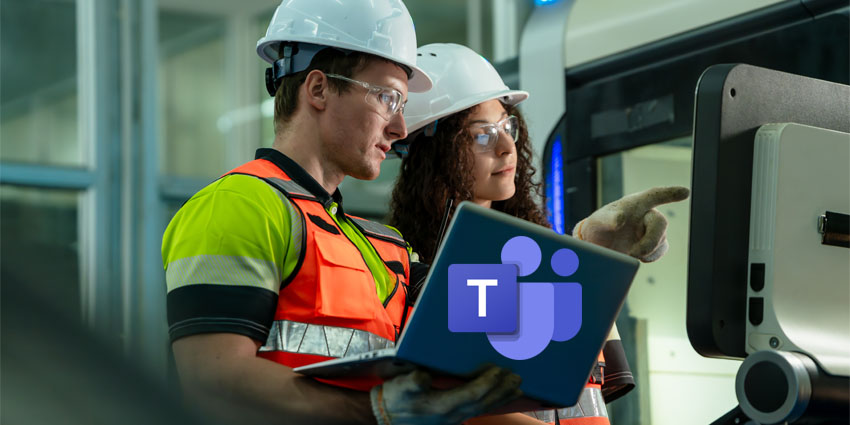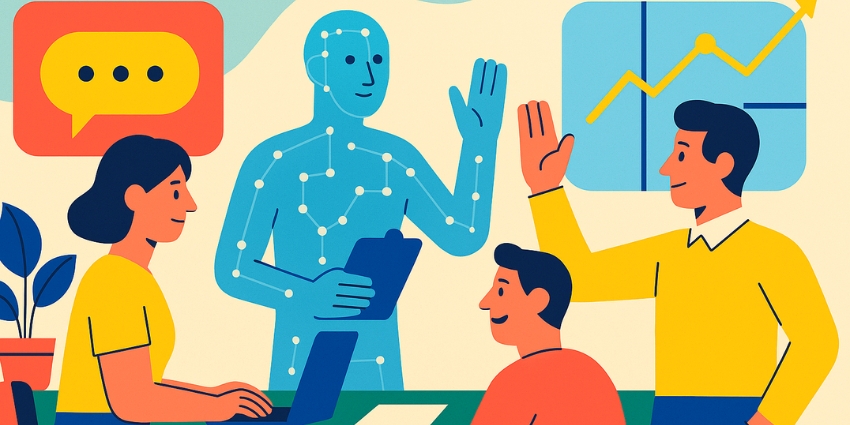The car business is changing gear. The sector that once relied on engines and intuition now operates on data, instant decisions, and people who can collaborate from anywhere: the factory, showroom, or service bay.
That’s the power of Microsoft Teams for Automotive. It brings design engineers, sales managers, and technicians together in a shared workspace, cutting through silos and enabling them to work as a single unit. When a part delay affects production or a customer contacts the dealership about a new EV, everyone can view the same information, discuss it, and take action quickly.
The impact of that type of connected collaboration is pretty clear. CallRevu utilized Microsoft’s AI tools to help car dealerships increase lead conversion by 15 percent, reduce missed opportunities by 20 percent, and enhance customer satisfaction by 10 percent, while saving approximately $500,000 annually in labor costs.
Jaguar Land Rover developed over 160 custom apps within Teams to streamline safety checks and logistics. Brisa Automotive cut 400 working hours by replacing long meetings with faster digital collaboration.
Plus, Microsoft’s AI focus is introducing new opportunities. Tools like the mobility copilots, revealed at CES 2025, highlight AI assistants that connect vehicle data, diagnostics, and customer service directly inside Teams.
Because in automotive now, performance isn’t only about horsepower, it’s about how fast your people can connect, decide, and deliver.
- Measuring and Maximizing Microsoft Teams ROI: The Enterprise Framework
- How CIOs Can Balance Microsoft Teams Governance with Productivity
Microsoft Teams for Automotive: Why Teams Need a Unified Hub
The car business used to be about building machines. Now it’s about keeping people and data moving in the same direction.
Every car company lives on coordination. Designers, engineers, supply-chain teams, and dealers all depend on one another. When the connection slips, deadlines drift, orders stall, and customers start asking questions nobody can answer.
Microsoft Teams for Automotive provides a shared workspace for everyone to collaborate side by side. Engineers can drop a design file straight into a chat instead of sending another email chain. Service teams can pull live stock data from Power BI dashboards. Sales staff can reach the factory in seconds through Teams Phone Mobile.
Electric cars, direct sales, and connected vehicles have changed how fast everything needs to move. A small design change in one region can ripple through production lines on another continent. Dealers can’t sit around waiting for updates to arrive overnight. They need live information, and they need it now.
The strongest automotive brands are no longer just efficient manufacturers. They’re fast communicators, companies where every department can talk, see, and solve together.
Breaking Down the Automotive Silos with Microsoft Teams
Every car brand talks about being “connected,” but inside most companies, the connection breaks down fast. Design teams use one system; sales and service teams use their own. Dealers keep customer records that never make it back to the manufacturer. The result can be missed leads, repeated work, and frustrated customers who can tell the left hand doesn’t know what the right one’s doing.
Microsoft Teams for Automotive helps close that gap. It’s the shared workspace where everyone, from the engineer building a prototype to the salesperson confirming a delivery, can see the same picture. Teams channels replace endless email threads. Shared dashboards show what’s actually happening across departments. Meetings happen instantly, not after a week of scheduling.
Factories, head offices, and dealerships can now communicate as one unified business. With Teams Phone Mobile, field workers and frontline staff stay reachable even when they’re out on the lot or in the service bay. Since Teams integrates directly with Dynamics 365 and Power BI, those calls and chats feed into the same customer data that drives sales and service decisions.
That kind of connected collaboration pays off.
Isuzu Motors in Japan replaced its legacy PBX system for Teams Phone and added 130 Teams Rooms across offices and factories. The move made communication faster and reduced missed calls between sites. ZF Group linked its factory workers with design and operations teams, letting frontline staff report issues or ideas directly through Teams.
When people don’t have to fight their tools, they share more, fix problems faster, and waste less time chasing updates that should already be available to them.
- Unlocking Microsoft Teams Phone’s True Business Value
- Microsoft Teams for Field Service: The Command Center Transforming Operations
The Connected Showroom: Reinventing Retail and CX
Buying a car isn’t what it used to be. Customers do their research online, compare deals on their phones, and expect the same quick answers they’d get from any modern retailer. Yet many dealerships still run on disconnected systems. That separation slows everything down and leaves customers waiting for callbacks that never come.
Microsoft Teams for Automotive helps close that gap between digital interest and real-world delivery. It turns dealerships into connected hubs, where sales, service, and marketing all work from the same source of truth. Leads can be transferred directly from the website into a shared Teams channel linked to CRM data in Dynamics 365.
In most dealerships, service managers don’t have time to chase technicians across the floor. With Teams, they can message them on the spot and keep work moving. Follow-ups with customers occur in the same space, where Copilot extracts the key information from the chat, notes the next action, and sends it back to sales.
CallRevu, a Microsoft partner, used Azure and AI to help dealers do exactly that, raising lead conversion by fifteen percent, cutting missed opportunities by twenty, and bumping satisfaction by ten, while saving about half a million dollars annually in staff time. Brisa Automotive connected its entire dealer network through Teams, saving 400 working hours and cutting down on travel between sites.
Localiza, one of Latin America’s biggest mobility providers, automated everyday tasks with Microsoft 365 Copilot, freeing up 8.3 hours per employee each month.
Microsoft Teams for Automotive: Driving Productivity
Every minute matters in this business. A shipment runs late, a part number gets mixed up, and the service team waits; suddenly, the whole chain slows down. Most of those hold-ups aren’t mechanical. They are communication problems.
That’s why Microsoft Teams for Automotive is showing up everywhere from design studios to loading bays. It gives people a single place to share updates, drawings, and quick fixes before a delay turns into a crisis. A production engineer can flag a materials issue in a Teams chat; procurement sees it right away. A quality lead can show a design tweak over a Teams Room instead of sending a dozen screenshots.
Jaguar Land Rover built over 160 in-house apps inside Teams using Power Platform tools. Those apps manage everything from safety checks to workspace booking, work that used to live in endless spreadsheets.
AGMC, BMW’s importer in the UAE, combined Teams with Azure AI to keep track of every vehicle moving through its massive service complex. The change meant employees stopped wasting time hunting for cars, and customers stopped waiting in line. With fewer gaps between departments, the number of dropped calls decreased, delays disappeared, and the overall customer experience became significantly smoother.
Aftersales Excellence: Empowering Technicians and Remote Experts
Every customer remembers what happens after the sale. A smooth repair or a quick response builds trust. A long wait or the wrong part can undo months of good work.
The challenge is that most service centers run on patchy communication. That’s where Microsoft Teams for Automotive makes a big difference. It connects the workshop, the manufacturer, and the customer-facing staff in one space. A technician can jump on a quick video call through Teams Remote Assist, show what’s happening on a vehicle, and get help from an expert halfway around the world. No waiting for email. No long explanations. Just a shared view and a fast answer.
Porsche Cars North America uses this kind of setup for complex diagnostics, pairing Teams with mixed-reality headsets so specialists can literally see what the technician sees. It’s like having a master mechanic standing right beside every apprentice, without the travel.
Add in analytics from Power BI and predictive data from Azure IoT, and the service team can spot potential issues before a customer even books in. AI copilots are starting to take that even further. Microsoft’s latest updates include multi-modal copilots that can summarize repair histories, surface warranty details, and even guide technicians through troubleshooting steps, all inside Teams.
Governance, Security & Compliance
When everything runs through the cloud, designs, customer data, supplier files, and financial reports, trust becomes the real engine that keeps things moving. One leak, one phishing link, or one unsecured file share can shut down a production line faster than any hardware fault.
The automotive world has learned that the hard way. Multi-tiered supply chains and dealer networks mean data moves across hundreds of companies every day. It’s fast, but it’s risky. That’s why security and compliance have become just as critical as performance or range.
Microsoft Teams for Automotive builds those guardrails into the workflow. Tools like Microsoft Purview and data loss prevention keep sensitive designs, customer details, and financial records safe, even when they’re shared across different organizations.
Advanced audit logging and Operator Connect compliance make sure every call and meeting can be tracked if it ever needs to be reviewed. That matters for brands working with government fleets, defense contracts, or regulated finance arms.
HOLLEN Automotive saw this play out firsthand. As the company expanded across Europe, it used Microsoft 365 Business Premium to modernize collaboration while tightening security. That change allowed the team to keep scaling without losing control over data or access.
- Microsoft Teams Enterprise Playbook: Building Success Beyond Meetings
- Driving Customer Success with Microsoft Teams Analytics
Microsoft Teams for Automotive: The Value & Playbook
Every collaboration platform promises productivity. The question executives ask is always the same: where’s the return?
In the automotive sector, that answer is finally clear. When Microsoft Teams for Automotive becomes the core of how people work, its value becomes evident everywhere.
A Forrester study on the Total Economic Impact of Teams found that full-scale adoption can drive returns of up to 832 percent when meetings, calls, and messages all happen on one platform. For automakers managing teams spread across continents, that efficiency can translate into faster product launches, shorter delays, and a more consistent customer experience everywhere.
Here’s a simple playbook to get there:
- Map the customer journey: Find the points where information gets stuck—between sales, service, and the factory floor.
- Connect CRM with Teams: Pull Dynamics 365 data into shared channels so everyone’s looking at the same story.
- Support frontline and contact center teams: Use Teams Phone and smart routing so customers reach the right person the first time.
- Add Copilots and Power Apps: Automate repetitive work and keep insights front and center.
- Set governance early: Align with IT and compliance before expanding across suppliers and partners.
- Measure what matters: Track conversion rates, repair times, and satisfaction through Power BI.
The Road Ahead with Microsoft Teams for Automotive
The next chapter of the automotive story will be written in data streams, from vehicles, customers, and the teams that connect them.
AI is already reshaping how automotive companies operate. Microsoft’s Copilot Studio enables businesses to create their own digital copilots for tasks such as scheduling, diagnostics, or customer support within Microsoft Teams for Automotive. Imagine a service manager asking, “Show me all vehicles with repeated sensor alerts this month,” and getting instant answers from across systems.
Collaboration is spreading across engineering, retail, and aftersales, and Teams is becoming the place where it all connects. It’s now a digital workspace where AI, IoT data, and people work side by side.
Azure’s expanding mobility network links vehicles, charging stations, and service centers, while Copilots and Fabric analytics turn that stream of data into decisions that actually move the business forward.
For automakers, that’s the difference between reacting and leading. It means predictive maintenance instead of breakdowns. Personalized sales follow-ups instead of generic emails. Faster product updates driven by real feedback from the road.







